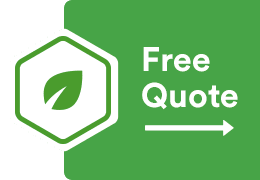Pollinators are under threat. Bees, butterflies, beetles, bats, and other insects are vital components of a thriving ecosystem, but recent studies indicate that pollinator populations are declining at rapid rates across the world.

Why are pollinators so important?
The existence of our environment and our society is dependent on pollinators, who carry pollen between plants, transferring key genetic material required for plant reproduction. One-third of the food we eat comes from pollinated plants, and these plants also account for half of the world’s oils, fibers, and other raw materials. Pollinators are also vital for the promotion of biodiversity, providing food and shelter for creatures within ecosystems, with 90% of all plants relying on cross-pollination to spread and grow.
But pollinators are not just responsible for food production; they also play a key role in maintaining healthy ecosystems that keep the air clean, supporting other wildlife, and stabilizing the surrounding soil and environment.
While we mainly associate bees with pollination, there are other creatures that play a pivotal role in pollination. Butterflies and moths are also valuable pollinators, as well as bats, who take the night shift in pollinating crops and spreading seeds. Beetles and flies, although not commonly thought of as pollinators, were actually the first insect pollinators of prehistoric flowers, around 150 million years ago.
But all kinds of pollinators are at risk. 19% of butterflies and moths are at risk of extinction, and more than half of the bat species in the U.S. are in decline or classed as endangered.

What are the threats to pollinators?
One of the biggest threats facing pollinators is the use of toxic pesticides, which contain chemicals that are incredibly harmful to pollinators. If a pollinator lands on a plant sprayed with pesticides, the toxic chemicals can paralyze and kill the insects rapidly. If a pollinator brings back any sort of residue to their habitat, an entire population of pollinators can be eradicated.
Climate change also represents a huge threat to pollinators. As temperatures warm, some flowers bloom earlier, and some pollinators lose their chance to feed and pollinate the flower. Shifting weather patterns caused by climate change have resulted in more extreme weather events such as heatwaves, hurricanes, and flooding. These extreme weather conditions can destroy pollinator’s habitats, making it much harder for them to survive and pollinate.
However, it’s not only climate change that is causing pollinators to lose their habitats. When forests and green spaces are replaced by urban development, entire ecosystems and pollinator habitats are destroyed. Without plants to pollinate or a home to live in, pollinators have very little chance of surviving.
What can we do?
Pollinators are crucial to our survival, and now it's time for us to return the favor. Turning to organic lawn care is an important step towards protecting our pollinators, as it does not contain any toxic chemicals that harm pollinators. Organic lawn care also helps to promote and maintain healthy soil life, which is safe and beneficial for pollinators' livelihood.
Planting native plants on your lawn can help create habitats for pollinators, especially if the plants are placed in clusters, as this makes them easier for pollinators to find. The best location to grow plants for pollinators is an area that is removed from the sun, receives partial sunlight, and can provide water to the plants.
Making sustainable lifestyle choices will help protect the environment and subsequently protect our pollinators. Taking steps to reduce your carbon footprint will help reduce pollution, which is a major driver of climate change. From using eco-friendly products/companies to composting food waste, every small sustainable action will help protect our pollinators.
Pure Solutions’ Commitment
At Pure Solutions, we take great care in ensuring our products are safe for pollinators. Our tick and mosquito products do not contain any toxic chemicals, and our technicians make sure to avoid spraying any flowering plants where pollinators may be. Additionally, we offer an organic lawn care service that is free from toxic chemicals that can harm pollinators, helping to curate lawns that are safe for pollinators to inhabit.
Sources:
7 Things You Can Do for Pollinators. Pollinator Partnership. (n.d.). https://pollinator.org/7things?gad_source=1&gclid=CjwKCAjwx-CyBhAqEiwAeOcTdbtynv3IlOCM4VLY1hF36tNroQuUAYPCnFtEBFTL_6XZnN2x09W8jxoCejsQAvD_BwE
Protecting Bees, Building Habitat, and Strengthening Communities Together. The Bee Conservancy. (2024, February 20). https://thebeeconservancy.org/?gad_source=1&gclid=CjwKCAjwx-CyBhAqEiwAeOcTddaOHYKsd4nSCUaiImwHwYikcTxuQ3UL4-OD2WaSc6EVxmIeLfvZMxoCJH0QAvD_BwE
Peters , V., & Grant, J. (n.d.). Pollinator Webinar. Earthwatch. https://earthwatch.org/science-matters-webinar-series/pollinators?gad_source=1&gclid=CjwKCAjwx-CyBhAqEiwAeOcTdT7gNm2pXIWzsqKvWzqKrl68v-i_Jaoz3wQ98GfNR9oEwzWVySMGJRoC3q4QAvD_BwE
Threats to pollinators: U.S. Fish & Wildlife Service. U.S. Fish & Wildlife Services. (n.d.). https://www.fws.gov/initiative/pollinators/threats
U.S. Department of the Interior. (n.d.). What is a pollinator?. National Parks Service. https://www.nps.gov/subjects/pollinators/what-is-a-pollinator.htm#:~:text=A%20pollinator%20is%20anything%20that,%2C%20seeds%2C%20and%20young%20plants.
Who are the pollinators?. Xerces Society for Invertebrate Conservation. (n.d.). https://www.xerces.org/pollinator-conservation/about-pollinators#:~:text=Butterflies%20and%20moths%E2%80%94both%20members,health%20of%20ecosystems%20and%20agriculture.

